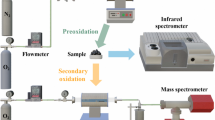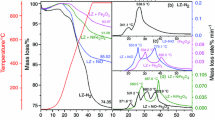Abstract
Serious fouling and slagging problems are associated with the combustion of Chinese Zhun-Dong coal due to its high content of sodium (Na). Understanding the release characteristic of Na during the combustion is essential to viable utilization of this coal. In this work, coal samples were treated with a sequence of solvents: water (H2O), ammonium acetate (NH4Ac), hydrochloric acid (HCl), and the release characteristics of various classes of Na during coal combustion were investigated using the technique of laser-induced breakdown spectroscopy. The relative contribution of various Na classes to the Na release during each combustion stage was found to be similar, in the order of H2O-soluble Na > NH4Ac-soluble Na > HCl-soluble Na > insoluble Na. Sodium released during the devolatilization stage can be attributed to each of the sodium classes. After the devolatilization stage, H2O-soluble Na and NH4Ac-soluble Na dominated the Na release during both char and ash stages. Over 64 % of the total Na released during combustion comes from the H2O-soluble Na, which suggests that the Na release during the combustion of Zhun-Dong coal can be reduced effectively after treatment by H2O washing.
摘要
新疆准东煤由于钠含量高, 其燃烧过程伴随严重的沾污腐蚀问题. 充分认识准东 煤燃烧过程中钠释放特性对其安全利用至关重要. 本文利用去离子水、醋酸铵溶液和盐酸溶 液依次对准东煤进行洗涤, 并结合激光诱导击穿光谱 (Laser-induced breakdown spectroscopy, LIBS) 技术对准东煤燃烧过程中不同形态钠的释放特性进行了实验研究. 研究表明, 不同形 态钠对燃烧中钠释放贡献程度的顺序为: 水溶钠>醋酸铵溶钠>盐酸溶钠>不溶钠. 每种形态 的钠均会在挥发分阶段释放, 而焦炭和灰分阶段的钠释放主要来自于水溶钠和醋酸铵溶钠. 整个燃烧过程64%以上的钠释放来自于水溶钠, 表明水洗处理可有效降低准东煤燃烧过程中 的钠释放.






Similar content being viewed by others
References
International Energy Agency (2014) World energy outlook 2014. IEA Publications, London
Xie JJ, Yang XM, Zhang L et al (2007) Emissions of SO2, NO and N2O in a circulating fluidized bed combustor during co-firing coal and biomass. J Environ Sci China 19:109–116
Yu DX, Xu MH, Yao H et al (2009) Size distributions of major elements in residual ash particles from coal combustion. Chin Sci Bull 54:958–964
Zhang Q, Geng GN, Wang SW et al (2012) Satellite remote sensing of changes in NO x emissions over China during 1996–2010. Chin Sci Bull 57:2857–2864
Toftegaard MB, Brix J, Jensen PA et al (2010) Oxy-fuel combustion of solid fuels. Prog Energy Combust Sci 36:581–625
Bryers RW (1996) Fireside slagging, fouling, and high-temperature corrosion of heat-transfer surface due to impurities in steam-raising fuels. Prog Energy Combust Sci 22:29–120
Wang XB, Xu ZX, Wei B et al (2015) The ash deposition mechanism in boilers burning Zhundong coal with high contents of sodium and calcium: a study from ash evaporating to condensing. Appl Therm Eng 80:150–159
Benson SA, Holm PL (1985) Comparison of inorganic constituents in three low-rank coals. Ind Eng Chem Prod Res Dev 24:145–149
Burchill P, Howarth OW, Sword BJ (1991) MAS N.M.R. studies of inorganic elements in coals and combustion residues. Fuel 70:361–366
van Eyk PJ, Ashman PJ, Alwahabi ZT et al (2011) The release of water-bound and organic sodium from Loy Yang coal during the combustion of single particles in a flat flame. Combust Flame 158:1181–1192
Zevenhoven-Onderwater M, Blomquist JP, Skrifvars BJ et al (2000) The prediction of behaviour of ashes from five different solid fuels in fluidised bed combustion. Fuel 79:1353–1361
Weng Q, Wang C, Che D et al (2014) Alkali metal occurrence mode and its influence on combustion characteristics in Zhundong coals. J Combust Sci Technol 20:216–221 (in Chinese)
Wibberley LJ, Wall TF (1982) Alkali-ash reactions and deposit formation in pulverized-coal-fired boilers: the thermodynamic aspects involving silica, sodium, sulphur and chlorine. Fuel 61:87–92
Lindner ER, Wall TF (1991) Sodium ash reactions during combustion of pulverised coal. Proc Combust Inst 23:1313–1321
Gallagher NB, Peterson TW, Wendt JOL (1996) Sodium partitioning in a pulverzed coal combustion environment. Proc Combust Inst 26:3197–3204
Gottwald U, Monkhouse P, Bonn B (2001) Dependence of alkali emissions in PFB combustion on coal composition. Fuel 80:1893–1899
Oleschko H, Schimrosczyk A, Lippert H et al (2007) Influence of coal composition on the release of Na−, K−, Cl−, and S-species during the combustion of brown coal. Fuel 86:2275–2282
Schürmann H, Monkhouse PB, Unterberger S et al (2007) In situ parametric study of alkali release in pulverized coal combustion: effects of operating conditions and gas composition. Proc Combust Inst 31:1913–1920
van Lith SC, Jensen PA, Frandsen FJ et al (2008) Release to the gas phase of inorganic elements during wood combustion. Part 2: influence of fuel composition. Energ Fuel 22:1598–1609
van Eyk PJ, Ashman PJ, Nathan GJ (2011) Mechanism and kinetics of sodium release from brown coal char particles during combustion. Combust Flame 158:2512–2523
He Y, Zhu J, Li B et al (2013) In-situ measurement of sodium and potassium release during oxy-fuel combustion of lignite using laser-induced breakdown spectroscopy: effects of O2 and CO2 concentration. Energy Fuel 27:1123–1130
Rusak DA, Castle BC, Smith BW et al (1997) Fundamentals and applications of laser-induced breakdown spectroscopy. Crit Rev Anal Chem 27:257–290
Song K, Lee Y-I, Sneddon J (1997) Applications of laser-induced breakdown spectrometry. Appl Spectrosc Rev 32:183–235
Lin Q, Wang X, Niu G et al (2014) Angular-based spatially resolved laser-induced breakdown spectroscopy: a new technique for the effective enhancement of signals without an external time delay system. Chin Sci Bull 59:3377–3384
He Y, Wang Z, Weng W et al (2014) Effects of CO content on laminar burning velocity of typical syngas by heat flux method and kinetic modeling. Int J Hydrog Energy 39:9534–9544
Huang Y, Yan Y, Riley G (2000) Vision-based measurement of temperature distribution in a 500-kW model furnace using the two-colour method. Measurement 28:175–183
van Eyk PJ, Ashman PJ, Alwahabi ZT et al (2009) Simultaneous measurements of the release of atomic sodium, particle diameter and particle temperature for a single burning coal particle. Proc Combust Inst 32:2099–2106
Hsu LJ, Alwahabi ZT, Nathan GJ et al (2011) Sodium and potassium released from burning particles of brown coal and pine wood in a laminar premixed methane flame using quantitative laser-induced breakdown spectroscopy. Appl Spectrosc 65:684–691
Quyn DM, Wu H, Hayashi JI et al (2003) Volatilisation and catalytic effects of alkali and alkaline earth metallic species during the pyrolysis and gasification of Victorian brown coal. Part IV. Catalytic effects of NaCl and ion-exchangeable Na in coal on char reactivity. Fuel 82:587–593
Tchapda A, Pisupati S (2014) A review of thermal co-conversion of coal and biomass/waste. Energies 7:1098–1148
Kosminski A, Ross DP, Agnew JB (2006) Transformations of sodium during gasification of low-rank coal. Fuel Process Technol 87:943–952
Acknowledgments
This work was supported by the National Natural Science Foundation of China (51406178), China Postdoctoral Science Foundation (2014M551732), National Basic Research Program of China (2012CB214906), and Specialized Research Fund for the Doctoral Program of Higher Education of China (20130101110095).
Author information
Authors and Affiliations
Corresponding author
Ethics declarations
Conflict of interest
The authors declare that they have no conflict of interest.
About this article
Cite this article
He, Y., Qiu, K., Whiddon, R. et al. Release characteristic of different classes of sodium during combustion of Zhun-Dong coal investigated by laser-induced breakdown spectroscopy. Sci. Bull. 60, 1927–1934 (2015). https://doi.org/10.1007/s11434-015-0922-9
Received:
Accepted:
Published:
Issue Date:
DOI: https://doi.org/10.1007/s11434-015-0922-9




